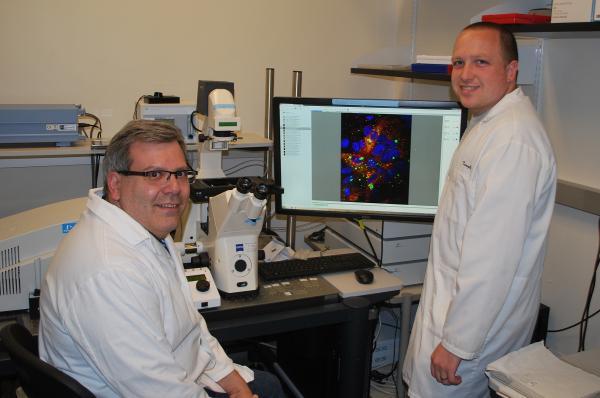Respiratory syncytial virus (RSV) can affect almost anyone of any age, showing itself like a bad cold in adults and older children. But in younger children, particularly infants, it can become something much worse.
RSV is the most common cause of acute lower respiratory infections in infants and young children globally, often leading to bronchiolitis or pneumonia, sending about 3 million children to the hospital each year. In spite of its prevalence, there is no effective vaccine yet. But researchers at the Georgia Institute of Technology are on the case.
“Treatments and vaccines are currently being investigated, and there might be a vaccine soon, but we really don’t know a lot about the cellular events that occur during RSV,” says Phil Santangelo, associate professor in the Wallace H. Coulter Department of Biomedical Engineering and a researcher with the Petit Institute for Bioengineering and Bioscience.
Santangelo’s lab decided to look closer at RSV, to dig a little deeper,
“We’re imaging the genome of the virus, the guts of it, looking at what happens inside the cell in the hopes of developing new drug targets,” says Santangelo, whose lab’s research was published recently in the journal Nature Communications. “Live cell imaging was the key to this research.”
The research, entitled RSV glycoprotein and genomic RNA dynamics reveal filament assembly prior to the plasma membrane, could lead to the development of antivirals against RSV and other viruses that use the secretory membrane system during assembly.
Finding the Unexpected
RSV is a cell membrane-wrapped, single-stranded RNA virus (which is closely related to other RNA viruses, such as measles and mumps) that assembles into viral filaments that can be seen on the outside of the cell.
The researchers utilized live cell imaging (with a major assist from research scientist Aaron Lifland, technical director of the microscopy core facility), as well as protein probes developed in Santangelo’s lab, and bioconjugation techniques – Lead author Daryll Vanover (a grad student in Santangelo’s lab) used fluorescently-labeled soybean agglutinin to selectively label the RSV G protein (which plays an important role in the assembly of filamentous virions) in living cells. And the results were remarkable, something Santangelo calls, “a mind-blowing event.”
It turns out, most of the viral components needed for filament formation in RSV assemble within the cytosol, not at the plasma membrane.
“The long filamentous structures we see on the outside of the cell, are made inside of the cell,” Santangelo says. “This is not what we expected at all. The dynamics we saw inside the cell are amazing. We’d never seen these structures inside the cell.”
There’s a lot of protein traffic inside of a cell. Future research from the Santangelo team will explore, in a deeper way, what components of the secretory membrane system are critical for specific protein trafficking into the assembly pathway, and applications of this research may lead to the development of new, effective drugs, “small molecules that would inhibit the trafficking and assembly process – assembly inhibitors,” Santangelo says.
“We haven’t seen that class of drugs – that actually inhibit assembly,” he adds. “It would be fantastic if you trap the virus inside the cell. If the virus stays there, it’s going to be degraded.”
In addition to Vanover, Santangelo, and Lifland, authors of the research include biomedical engineering (BME) grad students Emmeline Blanchard and Jonathan Kirschman, BME undergrad Daisy Smith, as well as Eric Alonas (a Santangelo lab alum who earned his Ph.D. last year), and Coulter Department research scientist Chiara Zurla.
CONTACT:
Jerry Grillo
Communications Officer II
Parker H. Petit Institute for
Bioengineering and Bioscience
Media Contact
Jerry Grillo
Communications Officer II
Parker H. Petit Institute for
Bioengineering and Bioscience
Keywords
Latest BME News
Jo honored for his impact on science and mentorship
The department rises to the top in biomedical engineering programs for undergraduate education.
Commercialization program in Coulter BME announces project teams who will receive support to get their research to market.
Courses in the Wallace H. Coulter Department of Biomedical Engineering are being reformatted to incorporate AI and machine learning so students are prepared for a data-driven biotech sector.
Influenced by her mother's journey in engineering, Sriya Surapaneni hopes to inspire other young women in the field.
Coulter BME Professor Earns Tenure, Eyes Future of Innovation in Health and Medicine
The grant will fund the development of cutting-edge technology that could detect colorectal cancer through a simple breath test
The surgical support device landed Coulter BME its 4th consecutive win for the College of Engineering competition.








